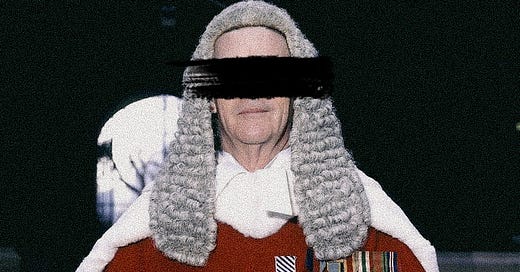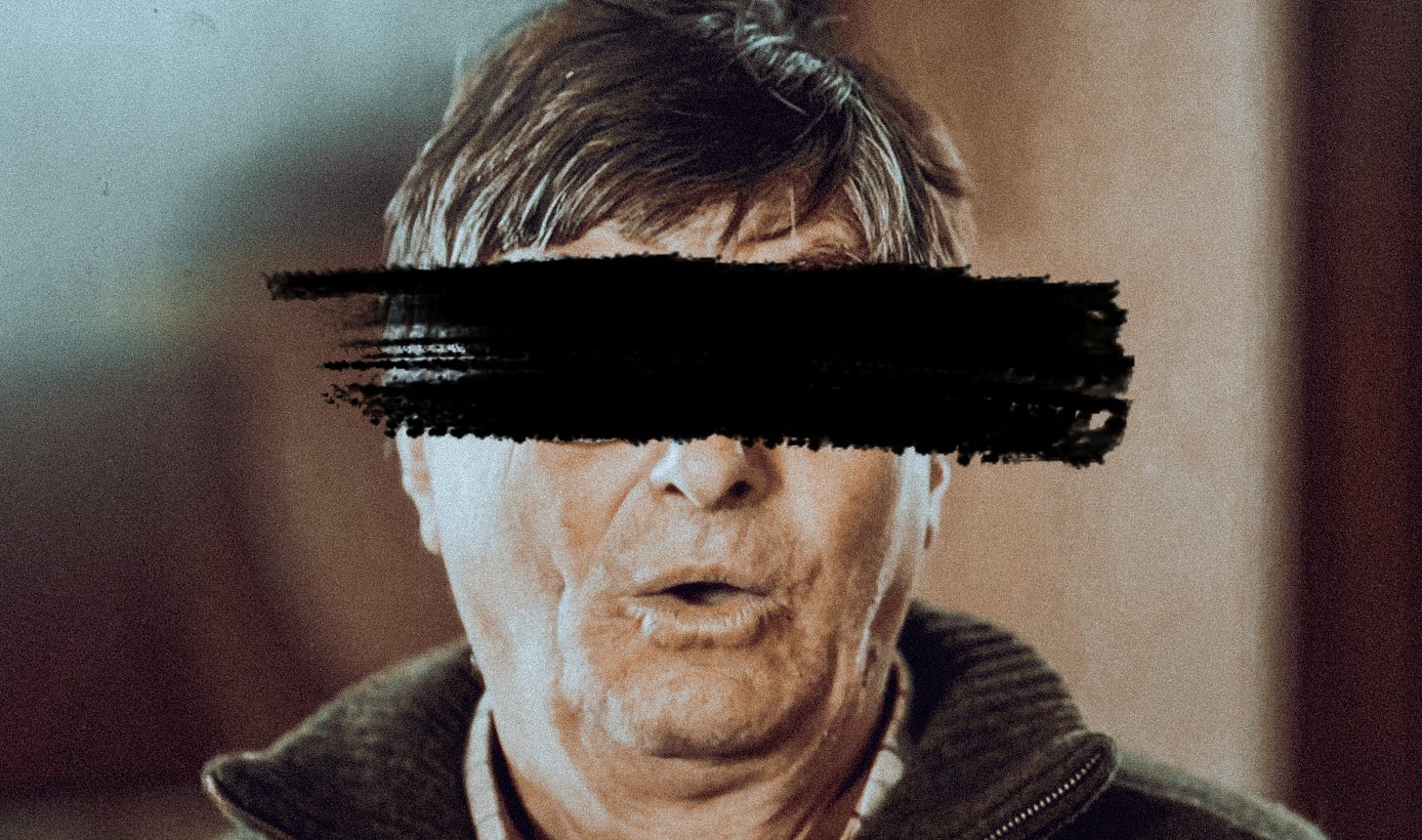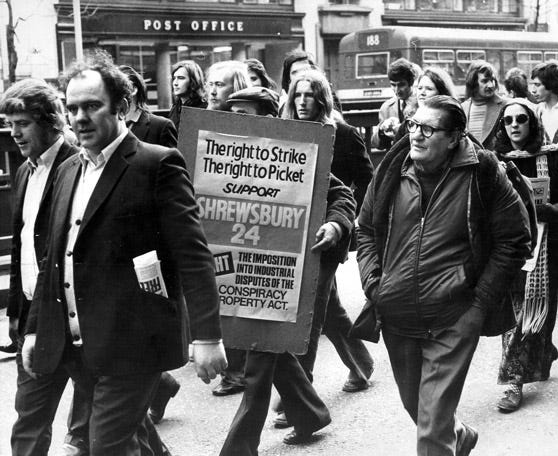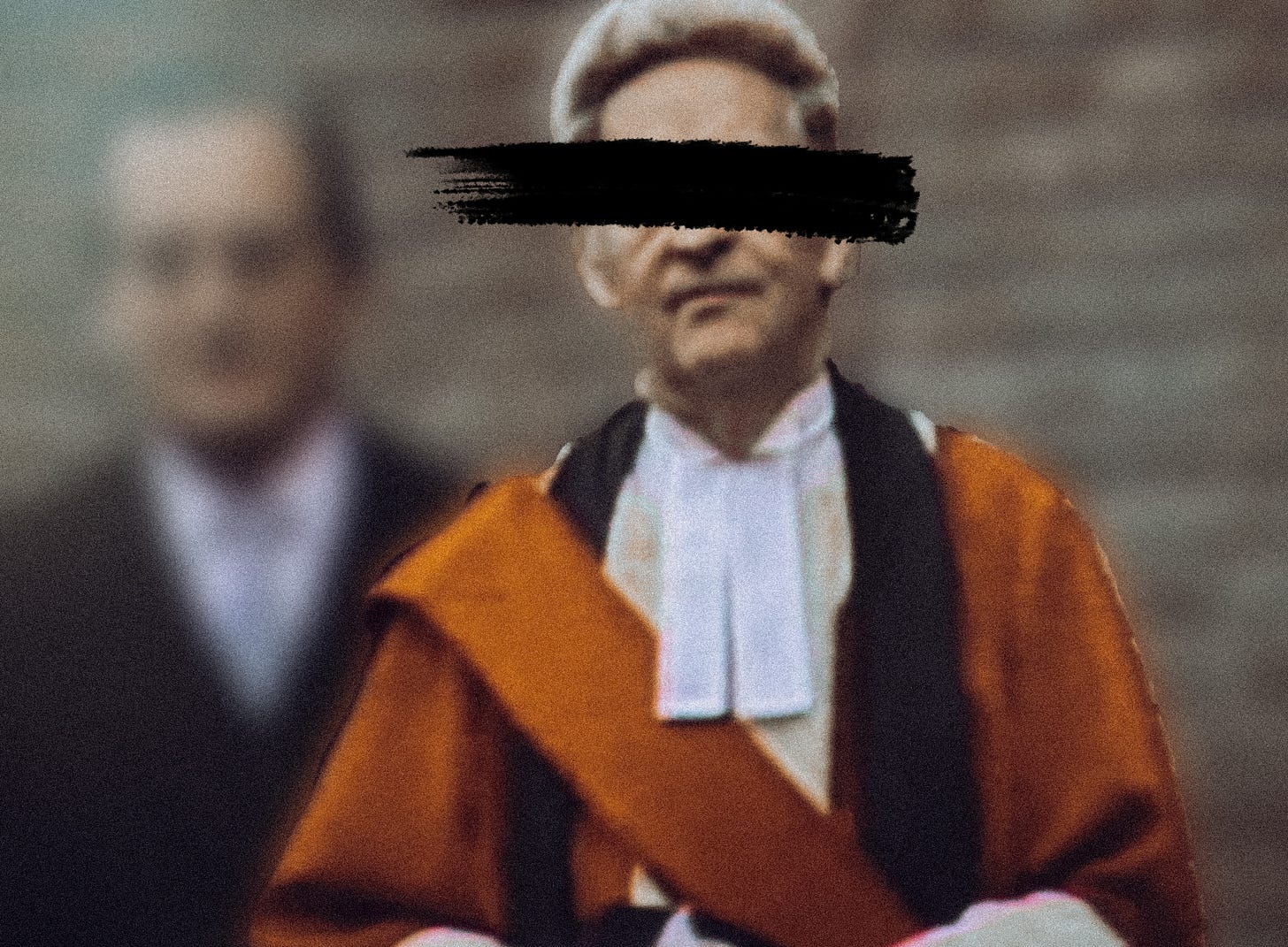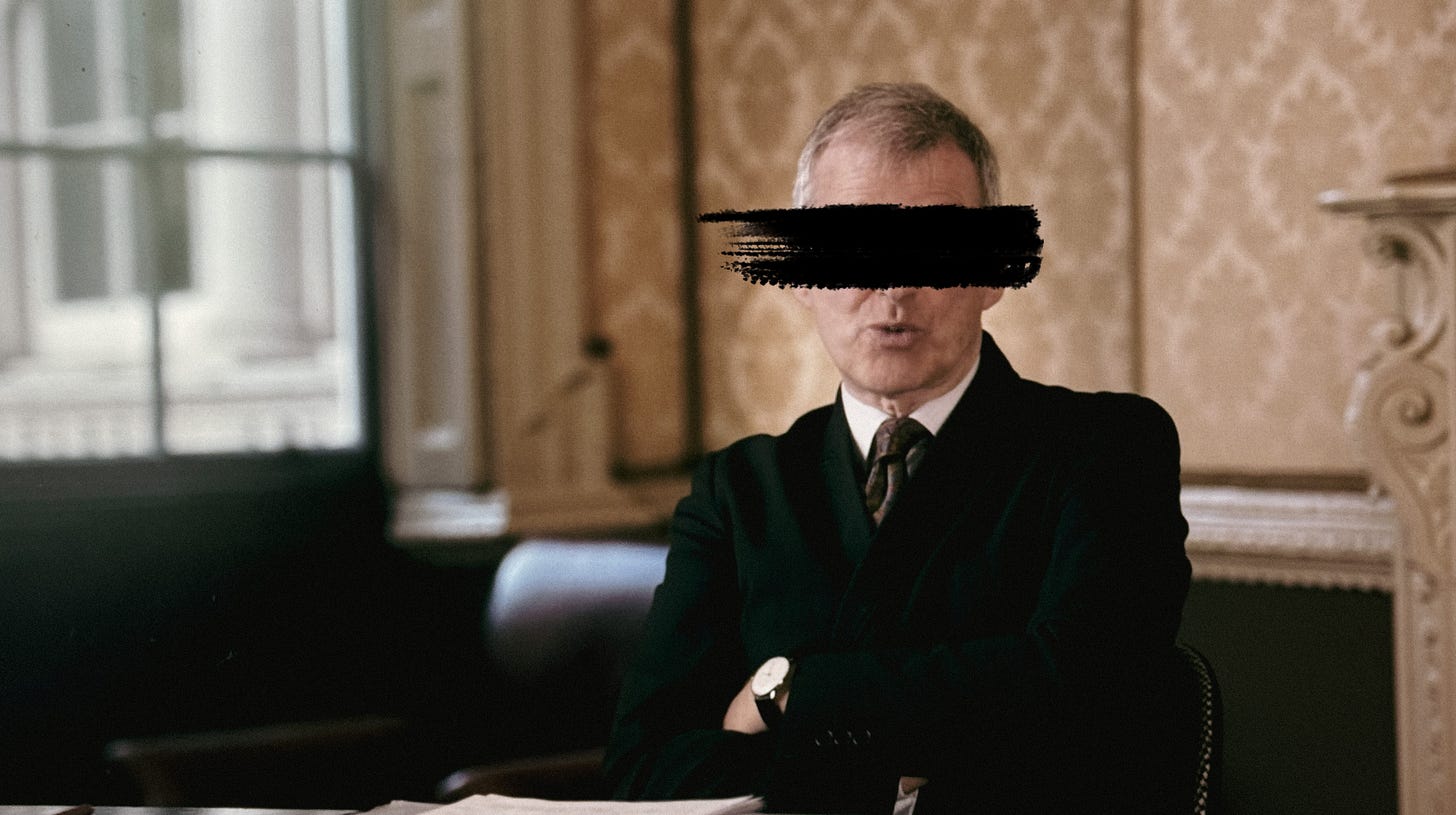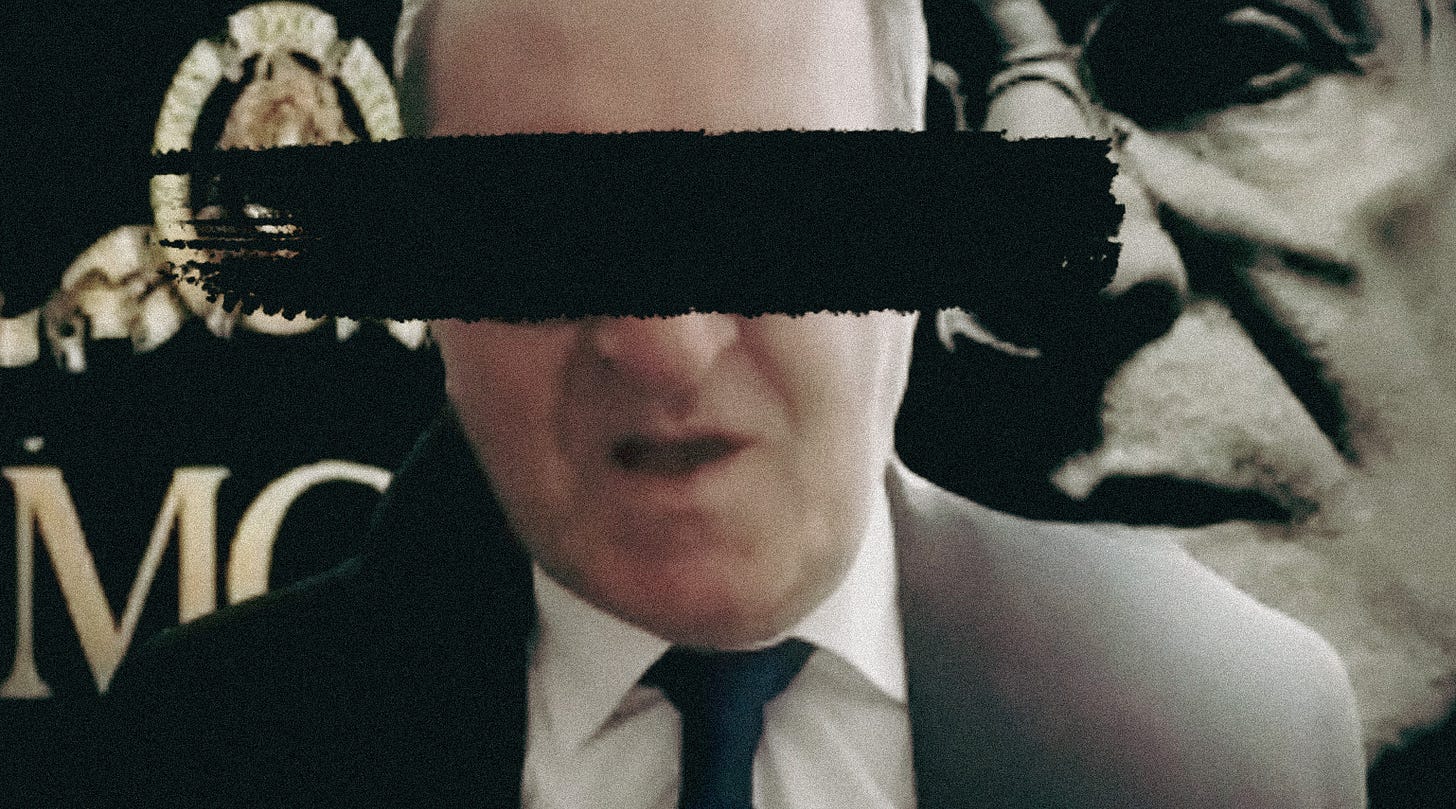American professor and intellectual Noam Chomsky once explained how those in powerful positions reach these positions after a long process of idealogical conditioning and careful selection via the education system. Only the very best - those most obedient to power - make it to the top. They are there to keep the system of power running smoothly.
Maurice Drake, the judge in Jeremy Bamber’s trial was educated at St George's School, Harpenden, Hertfordshire. He served in the RAF in WWII, and when the war ended, he completed his studies at Exeter College, Oxford. He was called to the bar in 1950 and appointed a High Court Judge in 1978.
A controversial character, he was also well known as a high ranking Freemason. In one murder case, in 1996, in which he was inexplicably bought out of retirement to oversee, the defence asked for him to stand down due to his Masonic connections. In what represents an unusual incident in the history of the British judicial system, Drake agreed.
He was a very fine, upstanding man. He was fairly on in his years. He stood no nonsense. He would put people down and say, that's enough of that.
David Boutflour, Bambers : Murder at the Farm, Sky on Justice Drake
There are other cases, in his role as a judge that also proved controversial, specifically in the case of former Police Superintendent and convicted paedophile Gordon Anglesea. A trial where he famously quoted,
Many jurors would find it difficult to believe that a married man could have a full sexual relationship with his wife at the same time as he was committing buggery.
It’s worth a deep dive at some point into that case because of his Freemasonry connections cropping up again and highlighted in the Macur review.1
But there’s another story, before Drake was a judge, that is even more intriguing and involves a secret government agency, a TV documentary, the National Archives and another miscarriage of justice that has taken 50 years to unravel.
The Information Research Department
Most of us are averse to the idea that judges can be ‘bent’ or corruptible. Or at the very least biased. They’re there to offer their ‘judgement’ on two opposing arguments - the defence and the prosecution. The term ‘fair trial’ should literally be the beating heart at the centre of our justice system. Influencing the jury ‘should’ not be a part of their discourse. However, when their often misguided adherence is to the perception that they are working towards a wider societal good, it invariably is.
To understand how our ‘fine upstanding man’ would have become subservient to deep state actors we need to go back to 1973 and a documentary film called “The Red Under The Bed”.

In February 2017, activist-turned-actor Ricky Tomlinson claimed that this documentary was part of a British Government conspiracy in 1973 to jail a group of striking workers for offences linked to the 1972 builders' strike in Shrewsbury.
Tomlinson stated:
They made a film which went out on television the night the jury were out considering the verdict... and it was so anti-trade union that two of the jury changed their mind and brought a majority verdict in of 10-2 guilty. We found out this week that the film was designed, written, made and paid for by the security services.
I know, it sounds completely fantastical.
Turns out it’s true.
The security services involved in this film were a division of the Foreign and Commonwealth Office, unassumingly named the IRD (Information Research Department)2. Now documents revealed in the National Archives, uncovered in 2017, show that this office was real and in fact a secret division working directly with Special Branch. The IRD was instrumental in the production of this ‘documentary’ and Edward Heath, then Prime Minister gave his approval for its production, now evidenced in uncovered hand written notes and memos.
At the height of the cold war in 1973, the thought of trade unions taking over the country would have been considered intolerable by Heath’s Tory government. The chance to use this relatively new medium (televisions had only become commonplace in UK homes in the 1960’s) as a means of propaganda to ‘fix’ a trial would have been too good an opportunity to miss.
During the period of the 60’s and 70’s the IRD produced fake news, mainly directed at the USSR, namely anti-communist and black propaganda (against the Commonwealth countries), but also at leftist groups in the UK.
Operating for 29 years, the IRD is known as the longest-running covert government propaganda department in British history.
People know of the Birmingham 6 and the Guildford 4 because of their infamous convictions being eventually over-turned, but not so much about the Shrewsbury 24, as no-one was killed or injured, their case was purely politically driven.
From The Guardian,
The Shrewsbury 24 – including the Royle Family actor Ricky Tomlinson – were a group of activists campaigning for better pay and conditions during a 1972 builders’ strike; they were convicted of public order offences and sent to prison.
In 1972 building practices in the UK were, as you can imagine, pretty shocking by today’s standards. A couple of film students, Jeff parks and Michael Rosen, horrified at the fact that 6 strikers were imprisoned for picketing offences, made this remarkable film which gives a real understanding of seventies construction site working conditions.
Three months before the first trials at Shrewsbury, fourteen North Wales building workers were prosecuted at Mold Crown Court by Gwynedd police.
The Crown prosecutor at Mold was none other than Maurice Drake QC. He and his team were to go on to prosecute the 24 pickets in the three trials at Shrewsbury. The prosecutors had used the Mold trials as a dress rehearsal for the main production. They were determined to use the lessons that they had learned from these trials to ensure that they obtained convictions of all the pickets at Shrewsbury.3
The Shrewsbury activists, who were campaigning for better wages and conditions in the building industry, went to seven different sites on 6 September 1972. Tomlinson, who later found acting success in Brookside, Cracker and The Royle Family, says there was no trouble, and recalls that the police made no arrests or cautions on the day. However five months later, in February 1973, they were arrested and charged with offences including intimidation, conspiracy to intimidate and unlawful assembly; 24 men were convicted after three separate trials.
They have been fighting, via their campaign team, for justice, like Bamber and his team, for decades.
Since 2012 the CCRC had been considering referring their case to the Court of Appeal. In 2017 documents were released to parliament suggesting, guess what?
Police had destroyed original witness statements and framed new testimony to convict activists. But still documents were being held back.
Sound familiar?
Andy Burnham, shadow home secretary at the time said4
What possible justification can there be, 43 years on, for information about it to be withheld on national security grounds?
The failure to disclose has less to do with national security and much more to do with the potential for political embarrassment.
Again, sound familiar?
AND SO TO MAURICE
In 2015 the Guardian reported,5
On 20 September 1973, in the late stages of preparing the case, a note of a conference with Maurice Drake QC, the lead prosecution barrister, apparently made by a police officer, states: “It was mentioned that not all original handwritten statements were still in existence, some having been destroyed after a fresh statement had been obtained.”
“In most cases the first statement was taken before photographs were available for witnesses and before the officers taking the statements knew what we were trying to prove.”
The Shrewsbury 24 campaign’s solicitor, Rhona Friedman, of Bindmans, who made the application to the CCRC, said the note “has the potential to be the most shocking and revelatory document detailing possible prosecutorial abuse of process that I have seen”. She added: “It suggests that the police may have gathered evidence in this case to fit a predetermined narrative and destroyed evidence which didn’t fit.”
So Drake, as prosecuting QC, knew the police had destroyed and fabricated evidence to suit their needs. What did Chomsky say again? “Only the very best - those most obedient to power - make it to the top. They are there to keep the system of power running smoothly.”
The longest prison term served by a striker was three years.
It’s an interesting case that is worth reading more on, and equally as interesting is what seems to be a recurring MO of the CCRC: Once again they turned down the campaigners application in 2017 (after having it on their desk since 2012), the campaign went on to successfully challenge the CCRC at Judicial Review in 2019, the CCRC were persuaded to reverse their original decision, the picket’s conviction were referred to the Court of Appeal in 2020 and the convictions finally overturned on 23 March 2021.
48 years since the original conviction. They say the wheels of justice turn slowly. Glacial is a better term.
Of note from the campaigners website, 6
It had taken the CCRC eight years to accept that the fresh evidence we had submitted was credible.
Helen Pitcher, CCRC Chairman stated,
Some will think this has not been the Commission’s finest hour.
The CCRC seems to have very few ‘finest hours’.
So with Drake’s unequivocal MO of deference to the police, the question is,
DID JEREMY BAMBER RECEIVE A FAIR TRIAL?
We now know the evidence presented at Bamber’s trial was suspect at best, but we also need to consider the inherent bias that Drake would have felt. Freemasonry ‘may’ have played a role - this is for another post - but more interesting is going back to his WWII experience.
Drake was in 255 squadron flying night patrols in Bristol Beaufighter aircraft over Africa and Italy. At the same time Nevill Bamber was flying Mosquitoes in North Africa. Were they ever in the same squadron? Unlikely , but at trial Drake would have been aware of Nevill’s RAF background and so the thought of Nevill being murdered by his ne'er-do-well son would most definitely have played some influence in his approach to the case.
Bamber on his father,
He was a pilot with Mosquitoes.
Dad loved flying them and he always missed it after the war that he'd not been able to fly. He always wanted to, to, to get in a plane and go flying and just never had the money or never had the opportunity to go flying again.
Flew loads in North Africa. Loved it. Absolutely loved it. And had a couple of quite bad crashes, actually. That's how he did his back in.
It’s plainly evident in KC Patrick O’Connor’s interview from the Sky Doc series that there was definitely unfairness at play in Drake’s summing up,
The judge, he or she, should preside fairly over the process of the trial in terms of who's calling what evidence and admissibility. The other part of the judge's role is to sum up the case to the jury, and sometimes this could, of course, be very influential on the jury's conclusions.
I've been a barrister for 50 years now and have conducted many criminal trials and appeal cases, miscarriage of justice cases. I have been able to review the summing up in the Bamber trial. I've had no previous involvement in the case and hopefully I have reached an entirely objective view of the conduct of this summing up by the trial judge.
A very important prosecution witness was Jeremy Bamber's girlfriend, Julie Mugford, and the judge spent 10 pages, absolutely rightly, summing up her evidence in detail. I mean, incidentally, he tried to shore up her evidence and criticised the defence for that approach to her evidence, etc. Nothing wrong with that.
But there was another, at least equally important witness in the case and that was Jeremy Bamber himself. He spent some days in the witness box and the jury had to be sure that he was not telling the truth. Now, I went through the summing up and I was waiting and waiting and waiting to find the judge's summary of his evidence and it's not there.
I'm absolutely amazed.
That is extraordinary and very unfair. All I will say is it can't have been an oversight because it's such an important aspect of the trial.
There's no question that from the tone and content of the rest of the summing up, the jury will have seen that he thought that Jeremy Bamber was guilty.
So this is a disincentive to acquittal and a significant one.
Patrick O’Connor KC, Doughty street Chambers, Bambers: Murder at The Farm, Sky
The Devils Advocate
Recently I had a call with Giovanni Di Stefano, the so-called Devils Advocate and one time ‘lawyer’ to the likes of Saddam Hussein, Kenneth Noye, John Palmer and Slobodan Milosevic amongst many infamous others. He’s only recently been released from prison having served 8 years of a 14 year sentence for fraudulently representing himself as a lawyer. Drake popped up in our conversation, as Giovanni had said in another recent interview, 7
In 2010 I met with Maurice Drake as I knew him. he said to me “I as the trial judge did my duty, but if you ask me to believe is this man(Bamber) guilty? The answer is no!”
Did this conversation happen? Difficult to know for sure, he did veer off on some (I’d use the word ‘bizarre’ but after learning about the IRD I’m not sure what that even means any more) conspiracy theories, but if Drake was so sure of Bamber’s innocence why was his approach at trial so obviously one-sided?
Assuming his line to Giovanni has something in it,
“I did my duty.”
Was he referring to that “duty” in deference to the police and prosecution’s case? The police had their man, Drakes role would be to make sure it stayed that way (the reputation of Essex Police was on the line due to the initial investigation where they had earned the nickname of ‘The Clouseau Squad’). We also now know Drake had form from 14 years earlier at the Shrewsbury trials.
Remember, he is there to keep the system of power running smoothly after all.
In Carol Ann Lees book, The Murders at White House Farm: Jeremy Bamber and the killing of his family she states,
One former member of the investigation team who does not wish to be named asked the jury foreman afterwards if there had been a deciding factor. He was told: ‘It was all down to the judge’s summing up. He directed us to find Jeremy guilty and that’s why we did, in the end. If it hadn’t been for the judge telling us what we should do, he would have walked free.’
In Book 2 of Ben Aaronovitch’s Rivers of London, there’s a great line that has stuck with me,
The Police can live with looking corrupt, bullying or tyrannical, but looking stupid is intolerable.
As for the IRD it was closed down in 1977, its existence not made aware to the public until 1978.8
Drake died in 2014.
Based on the handling of the Shrewsbury 24 application by the CCRC it could be 2031 until Jeremy Bamber sees any hope of justice.
A CCRC committee is scheduled to make a decision on Jeremy’s appeal in March 2025.
Jeremy Bamber has maintained his innocence for the entire 39 years he has spent in prison.
https://www.gov.uk/government/organisations/macur-review
https://powerbase.info/index.php/Information_Research_Department
https://shrewsbury24campaign.org.uk/history/the-mold-trials/
https://specialbranchfiles.uk/secret-memos-confirm-government-role-in-the-jailing-of-ricky-tomlinson/
https://www.theguardian.com/law/2015/dec/09/andy-burnham-shrewsbury-24-papers-published-documents-unions
https://shrewsbury24campaign.org.uk/the-campaign/introduction/
https://en.wikipedia.org/wiki/Information_Research_Department


